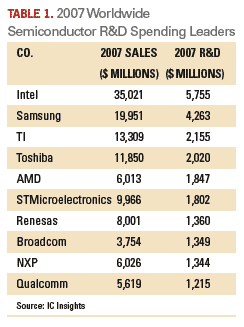
In the area of basic research, who will play? And who will pay?
As decisions are made for the future of the historic Bell Labs building in Holmdel, NJ, one must ponder where the next major semiconductor R&D breakthroughs will be made. Does basic research matter? Who will step up and fill the gap? Universities? Consortia? Increasingly, basic research is being carried out in universities and national laboratories with federal grants. Will the current financial crisis impact future R&D spending?
Played Out. Researchers at AT&T’s Bell Labs belonged to one of the world’s premier research institutes. Six researchers received the Nobel Prize in physics. Much of the early research in semiconductors traces its origins to Bell Labs, which opened in the late 1940s.1 But Alcatel-Lucent, its parent company, is pulling out of basic science, material physics and semiconductor research to focus on more immediately marketable areas such as networking, high-speed electronics, wireless, nanotechnology and software.2 While this may be a good short-term strategy, one has to wonder if whispered warnings from the ghosts of many a researcher of days gone by can be heard down the old hallways in Holmdel.
The late Jack Kilbey shared the Nobel Prize for work toward the invention of the integrated circuit in 1958. In January 2007, his benefactor, Texas Instruments, dropped its internal semiconductor research, stopping at the 45-nm node in favor of foundry-supplied processes.3 TI will depend on Taiwan Semiconductor Manufacturing Co., United Microelectronics Corp. and Semiconductor Manufacturing International Corp., rather than constructing its own leading-edge fabs for digital technology, focusing only on analog R&D. Will these foundries be able to support critical semiconductor R&D needed for next-generation production? Can these organizations turn out Nobel-quality research to lead us to the next technology? TSMC’s R&D budget in 2007 was $554 million. Without question, TSMC continues to make major contributions in semiconductors, but can it make key contributions in areas of basic research? Does it matter? What about the other foundries? Do they have the pockets to make much of a contribution? According to analysts at Goldman Sachs, UMC’s financial performance is suffering “due to the recent stock market weakness and discouraging semiconductor demand outlook.” Who can fill the gap?
Big Spenders? While some companies are on the decline in R&D spending, others appear to be able to step up to the plate. These companies include IBM, Intel and Samsung (Table 1). The danger is economic conditions could slow some of the R&D spending, as well as capital equipment purchases key to future semiconductor expansion.

For years, IBM maintained a billion dollar R&D budget. While others have scaled back on research, IBM is said to maintain large investments ($6 billion) in a variety of projects. IBM’s current research team includes five Nobel Prize recipients and more than a dozen National Medals of Science & Technology winners. The company is expected to maintain research projects of both short- and long-term (20 years).4
Intel’s third-quarter reports show R&D spending (plus MG&A) of approximately $2.9 billion. The annual R&D budget is close to $6 billion, nearly equal to the US Government’s budget for the National Science Foundation. This budget, however, must support not just semiconductor research, but also new PCs and future Internet products.
Samsung is another R&D powerhouse. The company reported overall R&D spending in 2007 of approximately $5.58 billion. Samsung’s R&D budget supports everything from consumer electronics to semiconductors. Unfortunately, Samsung is trimming its investment plans in memory this year and has postponed capital spending on its US factory because of the worsening global memory chip market.
The US financial crisis and potentially slowing global economy may hamper both corporate and government R&D spending. The most endangered expenditure likely is basic research. Will there be cuts to NSF? Universities? National labs? Does this make a difference? Maybe not in the short term, but definitely in the long run. PCD&F
REFERENCES
1. R. Colin Johnson, “Bell Labs Exits Chip Research,” EE Times, Aug. 29, 2008.
2. P. Ganapati, “Bell Labs Kills Fundamental Physics Research,” Wired Blog Network, Aug. 27, 2008.
3. P. Clarke, “Texas Instruments Exits Process Development Race,” Electronics Supply & Manufacturing, Jan. 24, 2007.
4. A. McConnon, “The Issue: Setting IBM’s R&D Agenda,” Business Week, April 16, 2008.














